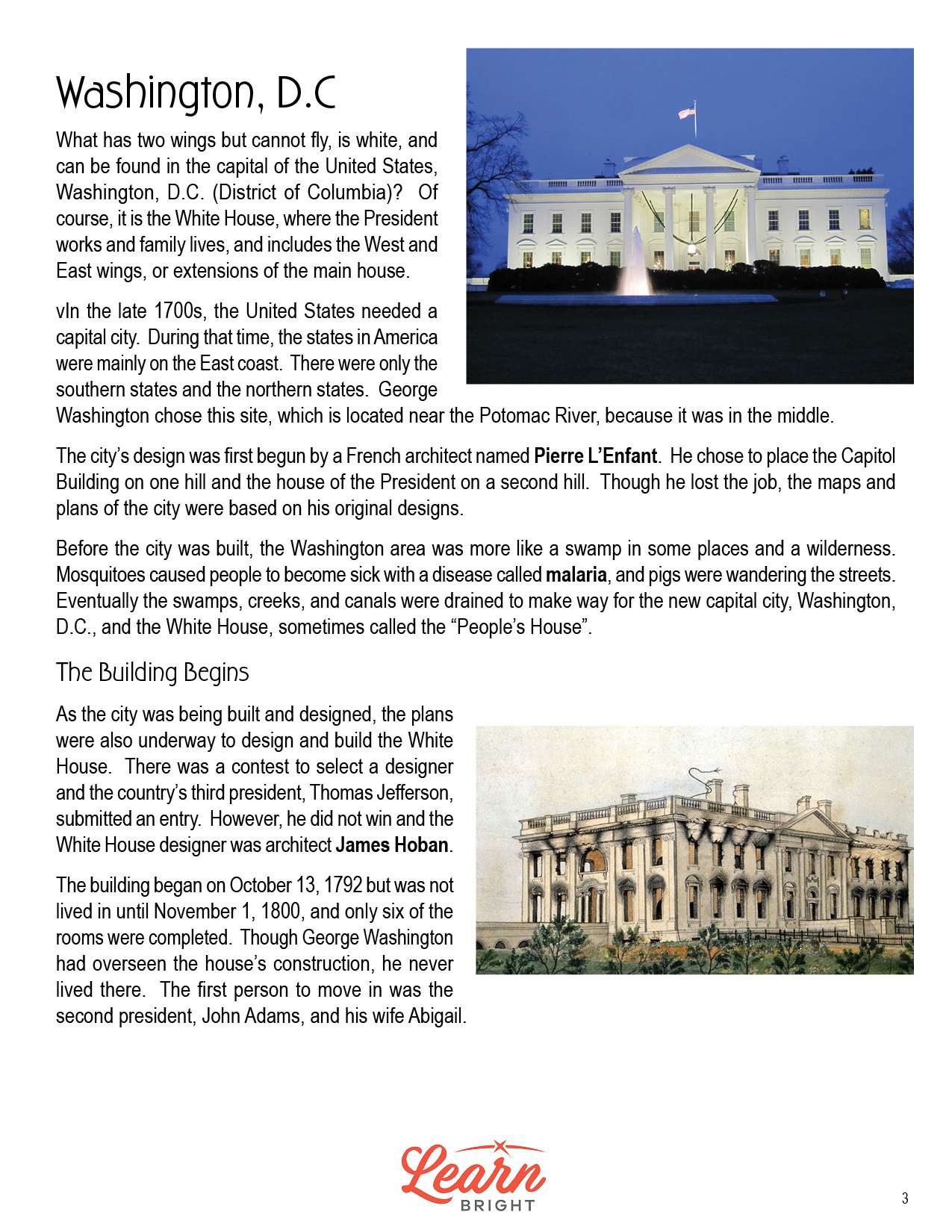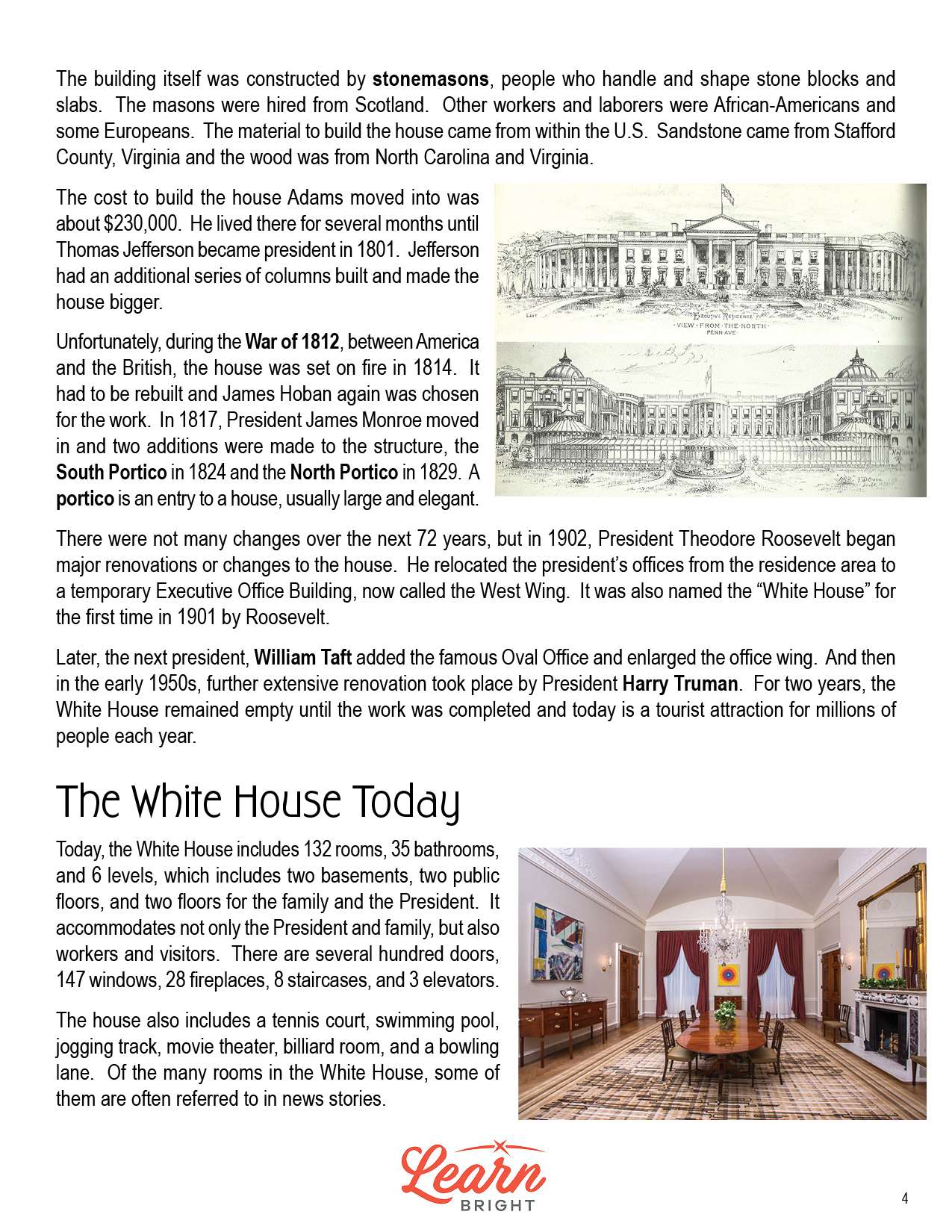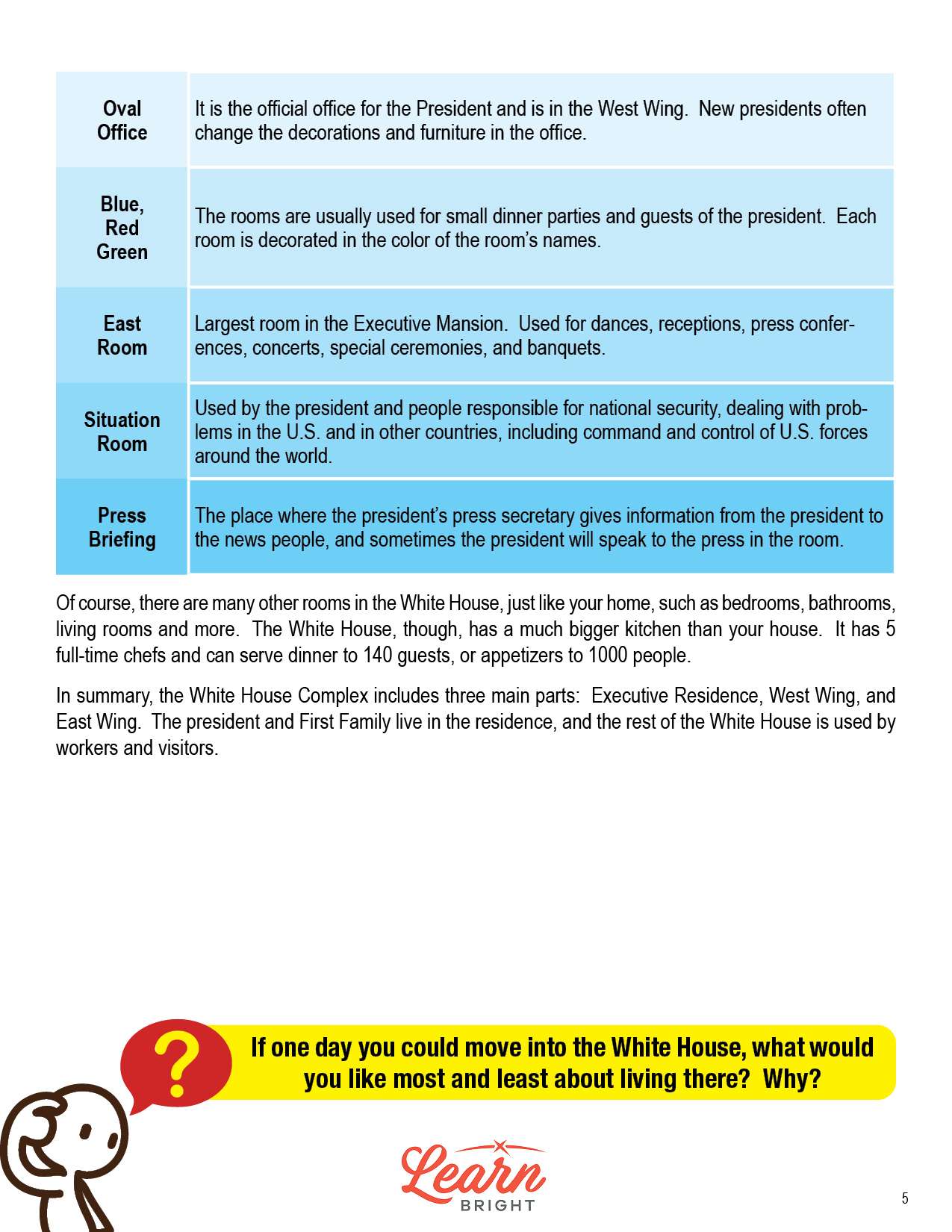Description
What our White House lesson plan includes
Lesson Objectives and Overview: White House introduces students to the White House in Washington, D.C., home of nearly all of the U.S. presidents. Many people visit the White House, but most students will not have the opportunity to see it in person. The lesson gives students interesting information and amazing facts about the White House. At the end of the lesson, students will be able to describe various parts of the White House and their significance, list interesting facts about the White House, and summarize its history. This lesson is for students in 4th grade, 5th grade, and 6th grade.
Classroom Procedure
Every lesson plan provides you with a classroom procedure page that outlines a step-by-step guide to follow. You do not have to follow the guide exactly. The guide helps you organize the lesson and details when to hand out worksheets. It also lists information in the yellow box that you might find useful. You will find the lesson objectives, state standards, and number of class sessions the lesson should take to complete in this area. In addition, it describes the supplies you will need as well as what and how you need to prepare beforehand.
Options for Lesson
Included with this lesson is an “Options for Lesson” section that lists a number of suggestions for activities to add to the lesson or substitutions for the ones already in the lesson. One optional addition to the lesson activity is to have each pair of students create only one invitation. You can also have your students create a 3D replica of the White House using craft sticks. You could also have students take a virtual tour of the White House on the internet. For an additional activity, you could have students design a new, smaller White House using graph paper to label dimensions. Finally, you could invite someone who’s been to the White House to speak to your class about their experience.
Teacher Notes
The teacher notes page includes a paragraph with additional guidelines and things to think about as you begin to plan your lesson. This page also includes lines that you can use to add your own notes as you’re preparing for this lesson.
WHITE HOUSE LESSON PLAN CONTENT PAGES
Washington, D.C.
The White House lesson plan includes three pages of content. The lesson begins by telling students that the capital of the United States is in Washington, D.C. The White House is the building where the President works and lives. It includes two extensions from the main house, the West and East Wings.
The U.S. needed a capital city in the late 1700s. Most cities in the United States at that time were located on the East Coast. George Washington chose a site for the capital that in the middle of the East Coast and on the Potomac River because it was in between the southern and northern states.
A French architect named Pierre L’Enfant began the city’s design. He chose to put the Capitol Building on one hill and the President’s house on another hill. L’Enfant lost the job, but the people who took over based the final maps and plans for the city on his designs.
Before they started building the city, the location that they chose was swamp-like and had many mosquitoes that gave people malaria. Pigs wandered the streets and it was like the wilderness. They had to drain the swamps, creeks, and canals to clear the area for the city and important buildings like the White House, which we sometimes call the “People’s House.”
The Building Begins
The people who designed the city of Washington D.C. decided to design and build the White House at the same time as the city. They held a contest to select the designer. An architect named James Hoban won, even beating the third President of the United States, Thomas Jefferson.
They started building the White House on October 13, 1792, but no one lived there until November 1, 1800, at a time when they had only completed six of the rooms. George Washington oversaw the construction of the building but never actually lived there himself. The second president, John Adams, was the first person to live there along with his wife, Abigail.
Scottish stonemasons, people who handle and shape stone blocks and slabs, constructed the building. African-Americans and Europeans also helped build the building. They build the building with sandstone from Stafford County, Virginia, and wood from North Carolina and Virginia.
It cost them about $230,000 to build the first White House building. John Adams lived there for a few months until they elected Thomas Jefferson as the third President in 1801. While living there, Jefferson ordered the building of additional columns and more rooms.
This original White House burned down during the War of 1812 between the United States and the British. They had to rebuild it and chose the same architect as the first time, James Hoban. President James Monroe moved into the new house in 1817. In 1824, they added the South Portico and in 1829, they added the North Portico. Porticos are large, elegant house entryways.
The White House stayed mostly the same until 1902, when President Theodore Roosevelt decided to renovate it. He separated the President’s office and residence, creating a temporary Executive Office Building that we now call the West Wing. This is also when the White House got its name! Roosevelt named the building the White House in 1901.
William Taft, the next President, added the Oval Office and made the office wing bigger. In the early 1950s, President Harry Truman did even more renovations, meaning that no one lived in the building for two years. Today, the White House is a major tourist attraction.
The White House Today
Today, the White House has 132 rooms, 35 bathrooms, 6 floors (including two basement levels, two public floors, and two floors for the President and their family). The President and their family lives there, but the building also accommodates workers and visitors. The building has hundreds of doors, 147 windows, 28 fireplaces, eight staircases, and three elevators.
You can also find a tennis court, swimming pool, jogging track, movie theater, billiard room, and bowling lane there. Different rooms in the house serve different functions.
The Oval Office is the official office for the President, located in the West Wing. A new President might change the furniture and decorations in this room when they take office. They use the Blue, Red, and Green rooms for small dinner parties and guests. They decorated each room using the color in its name. The East Room is the largest room in the Executive Mansion and they use it for dances, receptions, press conferences, concerts, special ceremonies, and banquets.
The President and other people responsible for national security use the Situation Room to deal with problems in the U.S. and in other countries. This is where they command and control U.S. forces all over the world. Finally, the President’s Press Secretary uses the Press Briefing room to give information to the news. The President sometimes speaks directly to reporters in this room as well.
The White House has many other rooms as well, like bathrooms and bedrooms. Five full-time chefs work in the kitchen and can serve dinner to 140 guests at a time, or appetizers for 1,000 people!
The White House complex includes the Executive Residence, West Wing, and East Wing. The President and their family live in the residence, while workers and visitors use the rest of the White House.
WHITE HOUSE LESSON PLAN WORKSHEETS
The White House lesson plan includes three worksheets: an activity worksheet, a practice worksheet, and a homework assignment. You can refer to the guide on the classroom procedure page to determine when to hand out each worksheet.
INVITATIONS ACTIVITY WORKSHEET
Students will work with a partner to complete the activity worksheet. Each pair will imagine that they’re overseeing an event at the White House and must send out invitations to visitors and guests. They will create three invitations, one for the Oval Office, one for the Blue, Red, or Green Room, and one for the East Room. For each room, they will come up with a specific event for that room. Their invitations should include the name of the event, the date and time, and any other information usually included on an event invitation. They will create a rough draft of each version, followed by a final version.
Students can also work either alone or in groups to complete this activity.
WHITE HOUSE PRACTICE WORKSHEET
The practice worksheet asks students to first match descriptions or definitions with the correct term. They will then tell the room or rooms where different events would most likely take place in the White House.
NUMBERS HOMEWORK ASSIGNMENT
For the homework assignment, students will tell the significance of each number, date, or year as it relates to the White House.
Worksheet Answer Keys
This lesson plan includes answer keys for the practice worksheet and the homework assignment. If you choose to administer the lesson pages to your students via PDF, you will need to save a new file that omits these pages. Otherwise, you can simply print out the applicable pages and keep these as reference for yourself when grading assignments.









